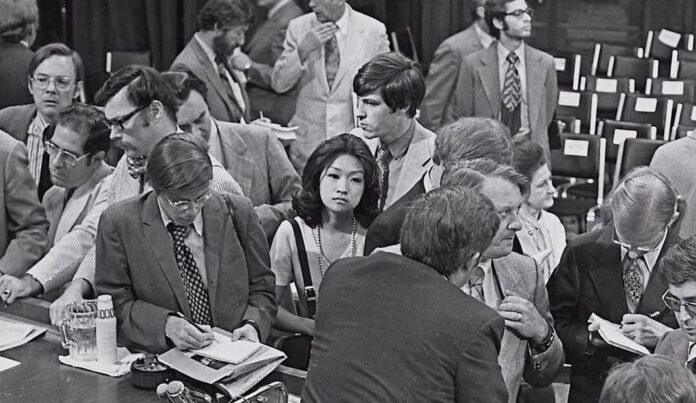By Lia Reichman, Asamnews Intern
The Asian American Journalists Association (AAJA) found local TV stations did a “poor job proportionately representing” Asian American Pacific Islander (AAPI) population in their communities.”
AAJA recently released these preliminary findings from their broadcast snapshot project that looked at the number of AAPI on-air staff working in local television stations.
AAJA specifically looked at data concerning reporters, anchors, meteorologists and TV hosts across the United States using Nielsen’s top 20 Designated Market Areas (DMA).
Waliya Lari, who led the project and is also AAJA’s Director of Programs and Partnerships, said they had heard “anecdotally” that members were seeing issues due to a lack of AAPI representation in their workplaces.
The issues that arose ranged from a lack of AAPI journalists in the newsroom to being “told that you’re too close to the stories” and thus couldn’t report on it.
“Overall stories weren’t being told of the AAPI communities and when they were being told they weren’t being told [as] thoroughly as they could have been,” Lari said. “That’s what we were hearing on the ground.”
With a growing AAPI population, proportionate representation concerns grew.
According to the Pew Research Center, data from 2000 to 2019 shows that Asian Americans recorded the fastest population growth rate of any racial or ethnic group in the U.S. The population grew from 10.5 million people to 18.9 million, an 81% increase. Native Hawaiians and Pacific Islanders were in their own categories, but they saw a substantial increase at 70% and 61%.
Despite almost half of the AAPI population living in the top 20 DMAs, AAJA found 25% of the stations had no AAPIs on air. And over 70% of the local TV stations did not have a proportionate amount of AAPI on-air staff to the AAPI in their DMA. Phoenix, Denver, Miami and Cleveland had an AAPI population comparable to their on-air staff. Philadelphia, Detroit and Orlando were a few of the markets with the least proportionate representation.
This snapshot project is the first of its kind at AAJA and Lari said she hopes this will lead to AAJA doing more research in the future.
“For communities to feel like they are respected, represented and a part of a larger community, is to see themselves reflected on T.V. I think that’s really important,” Lari said. “And once we can kind of figure out what the problems are, then we can start solving them. So we know kind of, in theory, what their problems are, this kind of helps us put into some hard numbers to quantify what the problem actually is.”
In a 2021 Radio Television Digital News Association (RTDNA) newsroom survey, data shows 2.8% of the local TV workforce is made up of Asian Americans.
This research was done in a partnership between the S.I. Newhouse School of Public Communications at Syracuse University and the RTDNA.
“The percentage of Asian Americans in local TV news is about half the Asian American workforce which is probably the worst relationship population of any group,” Bob Papper, Adjunct Professor of Broadcast and Digital Journalism at Syracuse University and one of the Directors of the survey, said.
Papper said one of the reasons for there being so few Asian Americans in the TV workforce and journalism may come from a “cultural basis” and the emphasis Asian American families may place on the STEM field.
“It’s possible that from a cultural standpoint, we don’t have a lot of Asian American families encouraging their kids to go into the [journalism] field. That they are more often encouraged to go into other fields, which notably, by the way, pay a lot more money,” Papper said.
He also noted that in the survey they also looked at the differences between men and women and their participation in the workforce. For White people, there were about 50% more men than women. In other racial groups excluding Asian like Hispanics, African American and Native Americans, the ratio is pretty close. But the numbers are quite different for Asian Americans.
“Asian Americans are the most lopsided of all the groups historically, and it’s changed a little but not much. Historically, Asian American women outnumber Asian American men on a two to one basis,” Papper said. “It’s the biggest discrepancy by gender that we see. There are about 50% more men than women among Whites. But it’s 100% among Asian American women over men.”
Papper said in his years of experience that having a diverse newsroom “is really easy to do, if it’s a priority” to those in power. It’s up to those who are hiring to consciously hire people of color.
“If what you’re going to do is view every opening as a problem that has to be solved as quickly as possible. Then you’re going to hire a bunch of White guys because they’re more of them than anyone else and you will not have a diverse staff,” Papper said. “If having a diverse staff is a priority, as it should be, then you’re patient enough to find people from diverse backgrounds.”
Lari said the rest of the findings from AAJA’s broadcast snapshot project will be released in the “next few weeks” with suggestions on how this type of research can go “broader” and “deeper”.
“It’s definitely a systemic issue, but nothing that can’t be addressed. But nothing’s intractable in all of this. It’s just a matter of doing the work,” Lari said.
She continued, saying that for some stations it only takes one AAPI journalist on air for the situation to go from“not acceptable to acceptable.”
“It’s a matter of commitment and prioritization. I think it’s very clear that anytime a newsroom makes something a priority, it gets done,” Lari said. “And that’s of any workplace. And so it’s a matter of making [it] a priority. The resources are there, It’s just a matter of actually walking the walk instead of just seeing that representation and diversity is important to us.”
AsAmNews has Asian America in its heart. We’re an all-volunteer effort of dedicated staff and interns. Check out our new Instagram account. Go to our Twitter feed and Facebook page for more content. Please consider interning, joining our staff, or submitting a story, or making a financial contribution.



